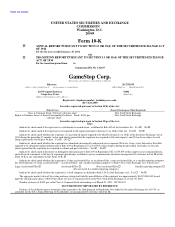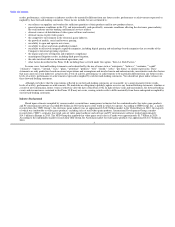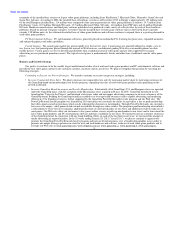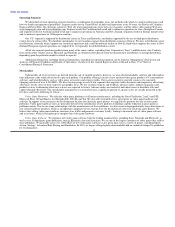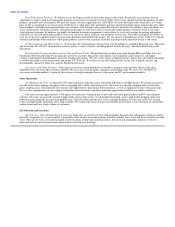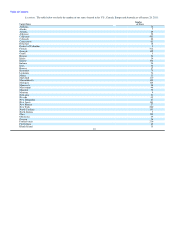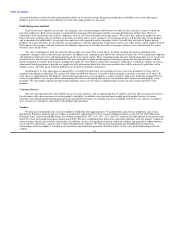GameStop 2010 Annual Report Download - page 21
Download and view the complete annual report
Please find page 21 of the 2010 GameStop annual report below. You can navigate through the pages in the report by either clicking on the pages listed below, or by using the keyword search tool below to find specific information within the annual report.
Table of Contents
remainder of the installed base consists of legacy video game platforms, including Sony PlayStation 2, Microsoft Xbox, Nintendo's GameCube and
Game Boy Advance. According to IDG, the installed base of hardware systems as of December 2010 in Europe is approximately 153 million units.
Of the total European installed base, 114 million were comprised of the current generation of video game platforms as follows: 14.7 million Sony
PlayStation 3 units, 24.9 million Nintendo Wii units, 13.7 million Microsoft Xbox 360 units, 14.8 million Sony PSP units and 46 million Nintendo
DS units. Hardware manufacturers and third-party software publishers have produced a wide variety of software titles for each of these hardware
platforms. Based on internal Company estimates, we believe that the installed base of video game software units in the United States currently
exceeds 1.98 billion units. As the substantial installed base of video game hardware and software continues to expand, there is a growing demand for
used video game products.
PC Entertainment Software. PC entertainment software is generally played on multimedia PCs featuring fast processors, expanded memories,
and enhanced graphics and audio capabilities.
Casual Gaming. The casual game market has grown rapidly over the last few years. Casual games are generally defined as simple, easy-to-
use, free or very low-priced games played through the internet in Web browsers, on dedicated gaming Web sites or on mobile phones or other
mobile devices. Casual games cost less to develop and distribute than a traditional console video game and are often supported by in-game
advertising or user-purchased premium content. The typical casual gamer is predominantly female and older than a traditional console video game
player.
Business and Growth Strategy
Our goal is to continue to be the world's largest multichannel retailer of new and used video game products and PC entertainment software and
provide the best video game content to our customers anytime, anywhere and on any device. We plan to strengthen that position by executing the
following strategies:
Continuing to Execute our Proven Strategies. We intend to continue to execute our proven strategies, including:
• Increase Comparable Store Sales. We plan to increase our comparable store sales by increasing market share by increasing awareness of
the GameStop brand and membership in our loyalty program, expanding our sales of used video game products and capitalizing on the
growth in demand.
• Increase GameStop Brand Awareness and Loyalty Membership. Substantially all of GameStop's U.S. and European stores are operated
under the GameStop name, with the exception of the Micromania stores acquired in France. In 2007, GameStop introduced its new
brand tagline "Power to the Players" and launched a television, radio and newspaper advertising campaign to increase awareness of the
GameStop brand. Building the GameStop brand has enabled us to leverage brand awareness and to capture advertising and marketing
efficiencies. Our branding strategy is further supported by the GameStop PowerUp Rewards loyalty program and our Web sites. The
PowerUp Rewards loyalty program was launched in 2010 and offers our customers the ability to sign-up for a free or paid membership
that offers points earned on purchases which can be redeemed for discounts or merchandise. Through PowerUp Rewards, our customers
have access to unique, video-game related rewards unavailable through any other retailer. The program's paid membership also includes
a subscription to Game Informer magazine, additional discounts on used merchandise in our stores and additional credit on trade-ins of
used games. Our Web sites allow our customers to buy games online, reserve or pick-up merchandise in our stores and to learn about the
latest video game products and PC entertainment software and their availability in our stores. We intend to increase customer awareness
of the GameStop brand. In connection with our brand-building efforts, in each of the last three fiscal years, we increased the amount of
media advertising in targeted markets. In the 52 weeks ending January 28, 2012 ("fiscal 2011"), we plan to continue to aggressively
promote the GameStop PowerUp Rewards loyalty program and increase brand awareness over a broader demographic area in order to
promote our unique buying experience in-store for new and used hardware and software, trade-ins of used video game products and to
leverage our Web sites at www.gamestop.com, www.ebgames.com.au, www.gamestop.ca, www.gamestop.it, www.gamestop.es,
5







